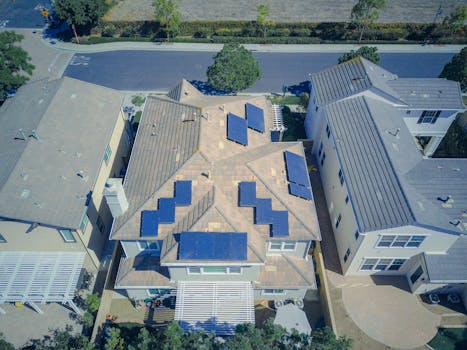“Empowering Multifamily Living: Overcoming Solar Mounting Challenges with Innovative Solutions.”
Solar mounting systems for multifamily properties present unique challenges and opportunities in the transition to renewable energy. These systems must accommodate diverse architectural designs, varying roof types, and the need for efficient space utilization while ensuring structural integrity and compliance with local regulations. Additionally, the shared nature of multifamily buildings complicates decision-making among multiple stakeholders, including property owners, tenants, and homeowners’ associations. Solutions to these challenges include innovative mounting technologies that enhance adaptability, community engagement strategies to facilitate consensus, and financial models that make solar investments more accessible. By addressing these issues, multifamily properties can effectively harness solar energy, reduce utility costs, and contribute to sustainability goals.
Structural Integrity: Assessing Load-Bearing Capacity
When considering the installation of solar mounting systems on multifamily properties, one of the foremost concerns is the structural integrity of the building. Assessing the load-bearing capacity is crucial, as solar panels, along with their mounting systems, can add significant weight to rooftops. This additional load must be carefully evaluated to ensure that the existing structure can support it without compromising safety or performance.
To begin with, a thorough structural assessment is essential. This process typically involves a detailed inspection of the building’s design, materials, and current condition. Engineers often utilize advanced tools and techniques, such as load calculations and structural modeling, to determine how much weight the roof can safely accommodate. These assessments take into account various factors, including the type of roofing material, the age of the building, and any previous modifications that may have altered its load-bearing capacity. By understanding these elements, property owners can make informed decisions about the feasibility of solar installations.
Moreover, it is important to recognize that different types of solar mounting systems can exert varying levels of stress on a building’s structure. For instance, ballasted systems, which rely on weight to hold the panels in place, may not be suitable for all roofs, particularly those that are not designed to handle additional loads. Conversely, penetrating systems, which involve attaching the panels directly to the roof structure, may require more extensive modifications but can provide a more secure and stable installation. Therefore, selecting the appropriate mounting system is a critical step in ensuring that the solar installation does not compromise the building’s integrity.
In addition to the initial assessment, ongoing maintenance and monitoring of the solar system are vital. Over time, factors such as weather conditions, wear and tear, and potential structural shifts can affect the load-bearing capacity of a building. Regular inspections can help identify any issues early on, allowing for timely interventions that can prevent more significant problems down the line. Property owners should work closely with qualified professionals who can provide expertise in both solar technology and structural engineering to ensure that the system remains safe and effective throughout its lifespan.
Furthermore, it is essential to consider local building codes and regulations when assessing load-bearing capacity. Many jurisdictions have specific requirements regarding the installation of solar systems, particularly in multifamily properties where multiple units may be affected. Compliance with these regulations not only ensures safety but also helps avoid potential legal issues that could arise from improper installations. Engaging with local authorities and obtaining the necessary permits can streamline the process and provide peace of mind.
Ultimately, addressing the challenges associated with structural integrity and load-bearing capacity is a critical component of successfully implementing solar mounting systems in multifamily properties. By conducting thorough assessments, selecting appropriate mounting solutions, and adhering to local regulations, property owners can harness the benefits of solar energy while ensuring the safety and longevity of their buildings. As the demand for renewable energy continues to grow, understanding these challenges and their solutions will be paramount in facilitating the transition to sustainable energy sources in multifamily housing. This proactive approach not only enhances the value of the property but also contributes to a more sustainable future for communities at large.
Space Optimization: Maximizing Roof Area for Solar Panels
In the realm of solar energy, the optimization of roof space for multifamily properties presents both challenges and opportunities. As urban areas become increasingly dense, the need for efficient energy solutions grows more pressing. Multifamily buildings, often characterized by limited roof space, require innovative approaches to maximize the area available for solar panel installation. This optimization is crucial not only for enhancing energy production but also for ensuring that the investment in solar technology yields the highest possible returns.
One of the primary challenges in optimizing roof space for solar panels is the structural limitations of multifamily buildings. Many older structures were not designed with solar energy in mind, leading to concerns about the weight-bearing capacity of roofs. Additionally, the presence of HVAC systems, skylights, and other rooftop equipment can further complicate the installation process. To address these issues, it is essential to conduct thorough structural assessments before proceeding with solar panel installation. Engaging with structural engineers can help property owners understand the load-bearing capabilities of their roofs and identify any necessary reinforcements.
Moreover, the orientation and angle of the roof play a significant role in determining the efficiency of solar panels. Ideally, solar panels should be installed on south-facing roofs with a pitch that maximizes sun exposure throughout the day. However, many multifamily properties feature flat or low-slope roofs, which can limit the effectiveness of traditional solar panel installations. In such cases, utilizing mounting systems that allow for adjustable angles can enhance energy capture. These systems can be designed to tilt panels toward the sun, thereby increasing their efficiency and overall energy output.
In addition to structural considerations, the layout of solar panels on the roof must be carefully planned to avoid shading from nearby buildings or trees. Shading can significantly reduce the performance of solar panels, making it essential to conduct a thorough shading analysis before installation. By using software tools that simulate sunlight exposure throughout the year, property owners can identify the optimal placement for solar panels. This proactive approach not only maximizes energy production but also ensures that the system operates at peak efficiency.
Another critical aspect of space optimization is the integration of solar panels with other rooftop features. For instance, green roofs and solar panels can coexist harmoniously, providing both energy generation and environmental benefits. By incorporating vegetation, property owners can improve insulation, reduce stormwater runoff, and enhance the aesthetic appeal of the building. This dual approach not only maximizes the use of available space but also contributes to the overall sustainability of the property.
Furthermore, advancements in solar technology have led to the development of more compact and efficient solar panels. These innovations allow for greater energy production in smaller footprints, making them ideal for multifamily properties with limited roof space. By selecting high-efficiency panels, property owners can achieve their energy goals without compromising on available area. Additionally, the use of building-integrated photovoltaics (BIPV) offers an exciting solution, as these systems can be seamlessly integrated into the building’s architecture, further optimizing space while enhancing the property’s design.
In conclusion, optimizing roof space for solar panels in multifamily properties involves navigating a range of challenges, from structural limitations to shading concerns. However, with careful planning, innovative mounting solutions, and advancements in solar technology, property owners can effectively maximize their roof area for solar energy generation. By embracing these strategies, multifamily properties can not only reduce their energy costs but also contribute to a more sustainable future.
Aesthetic Integration: Blending Solar Systems with Property Design
As the demand for renewable energy sources continues to rise, multifamily properties are increasingly turning to solar energy as a viable solution. However, one of the significant challenges that property owners and developers face is the aesthetic integration of solar mounting systems with existing architectural designs. Striking a balance between functionality and visual appeal is crucial, as the appearance of solar installations can significantly impact tenant satisfaction and property value. Therefore, understanding the nuances of aesthetic integration is essential for successful solar implementation.
To begin with, the design of solar mounting systems must consider the architectural style of the multifamily property. For instance, contemporary buildings may lend themselves well to sleek, low-profile solar panels that complement their modern lines. In contrast, historic properties may require more thoughtful approaches to ensure that solar installations do not detract from their classic charm. Utilizing solar panels that mimic traditional roofing materials or employing innovative mounting solutions can help maintain the integrity of the original design while still harnessing solar energy.
Moreover, the placement of solar panels plays a pivotal role in their visual impact. Strategically positioning panels on rooftops or integrating them into building facades can minimize their visibility from the ground. This approach not only preserves the aesthetic appeal of the property but also enhances the overall architectural narrative. Additionally, using solar canopies in parking areas or outdoor spaces can provide functional benefits while serving as an attractive design element. These canopies can create shaded areas for residents, thereby improving the usability of outdoor spaces while simultaneously generating renewable energy.
In addition to placement and design, color and texture are critical factors in achieving aesthetic integration. Many manufacturers now offer solar panels in various colors and finishes, allowing property owners to select options that harmonize with their building’s exterior. By choosing panels that blend seamlessly with the roof or facade, property owners can create a cohesive look that enhances the overall aesthetic. Furthermore, incorporating landscaping elements, such as green roofs or vertical gardens, can soften the visual impact of solar installations, making them a more integrated part of the property’s design.
Another important consideration is the use of advanced technology in solar mounting systems. Innovations such as building-integrated photovoltaics (BIPV) allow for the seamless integration of solar technology into building materials, such as windows and walls. This not only enhances the aesthetic appeal but also maximizes energy efficiency by utilizing surfaces that would otherwise remain unused. As technology continues to evolve, the possibilities for aesthetic integration will expand, offering multifamily properties even more options for incorporating solar energy without compromising design.
Ultimately, the successful integration of solar mounting systems into multifamily properties requires a collaborative approach involving architects, designers, and solar energy experts. By working together from the initial design phase, stakeholders can identify opportunities for aesthetic integration that align with both energy goals and architectural vision. This collaboration not only ensures that solar installations enhance the property’s appearance but also fosters a sense of community among residents who value sustainability.
In conclusion, while the aesthetic integration of solar mounting systems presents challenges, it also offers opportunities for innovation and creativity. By prioritizing design considerations, utilizing advanced technologies, and fostering collaboration among stakeholders, multifamily properties can successfully blend solar energy solutions with their architectural identity. This not only enhances the visual appeal of the property but also contributes to a more sustainable future, making solar energy an attractive option for multifamily developments.
Regulatory Compliance: Navigating Local Building Codes and Permits
When considering the installation of solar mounting systems for multifamily properties, one of the most significant hurdles property owners and developers face is navigating the complex landscape of regulatory compliance. Local building codes and permits are essential components of this process, as they ensure that solar installations are safe, efficient, and in line with community standards. Understanding these regulations is crucial for a successful solar project, as non-compliance can lead to costly delays, fines, or even the dismantling of installed systems.
To begin with, it is important to recognize that building codes vary widely from one jurisdiction to another. These codes dictate the structural integrity of solar mounting systems, including specifications for wind loads, snow loads, and seismic considerations. Multifamily properties, often characterized by their height and density, may face stricter requirements than single-family homes. Therefore, it is imperative for property owners to engage with local building authorities early in the planning process. This proactive approach not only helps in understanding specific requirements but also fosters a collaborative relationship with regulators, which can be beneficial in addressing any concerns that may arise during the permitting process.
In addition to building codes, obtaining the necessary permits is another critical step in the regulatory compliance journey. The permitting process can be intricate, often requiring detailed documentation that outlines the proposed solar installation’s design, engineering, and environmental impact. This documentation must demonstrate that the project adheres to local zoning laws, which may include restrictions on the height and placement of solar panels. Furthermore, multifamily properties may need to consider the aesthetic implications of solar installations, as some communities impose design guidelines to maintain the character of the neighborhood. Engaging with architects and engineers who are familiar with local regulations can streamline this process, ensuring that all necessary documentation is prepared accurately and submitted in a timely manner.
Moreover, it is essential to stay informed about any changes in regulations that may affect solar installations. As the push for renewable energy continues to grow, many local governments are revising their codes and permitting processes to encourage solar adoption. This can lead to new incentives or streamlined procedures that can benefit multifamily property owners. By staying connected with local solar advocacy groups or industry associations, property owners can gain insights into upcoming changes and best practices for compliance.
Another challenge that often arises is the coordination between various stakeholders involved in the project. This includes not only property owners and solar installers but also local government officials, utility companies, and sometimes even homeowners’ associations. Effective communication among these parties is vital to ensure that everyone is on the same page regarding compliance requirements. Regular meetings and updates can help mitigate misunderstandings and keep the project on track.
In conclusion, while navigating local building codes and permits can be a daunting task for multifamily property owners looking to install solar mounting systems, understanding the regulatory landscape is essential for success. By engaging with local authorities early, preparing thorough documentation, staying informed about regulatory changes, and fostering effective communication among stakeholders, property owners can overcome these challenges. Ultimately, a well-planned approach to regulatory compliance not only facilitates a smoother installation process but also contributes to the long-term sustainability and efficiency of solar energy systems in multifamily properties.
Q&A
1. **Question:** What are the main challenges of installing solar mounting systems on multifamily properties?
**Answer:** The main challenges include limited roof space, structural concerns, zoning and permitting issues, and the need for tenant engagement and approval.
2. **Question:** How can limited roof space be addressed in solar installations for multifamily properties?
**Answer:** Limited roof space can be addressed by using high-efficiency solar panels, optimizing panel layout, and considering alternative mounting options like carports or ground-mounted systems.
3. **Question:** What solutions exist for overcoming zoning and permitting issues in multifamily solar projects?
**Answer:** Solutions include working with local authorities early in the planning process, engaging with experienced solar developers familiar with local regulations, and exploring community solar programs.
4. **Question:** How can tenant engagement be improved to facilitate solar installations in multifamily properties?
**Answer:** Tenant engagement can be improved through educational outreach, transparent communication about benefits and costs, and offering incentives such as reduced energy bills or shared savings from solar energy.
Conclusion
Solar mounting systems for multifamily properties face challenges such as structural limitations, space constraints, and regulatory hurdles. Solutions include utilizing innovative mounting technologies, optimizing roof space through shared systems, and engaging with local authorities for streamlined permitting processes. By addressing these challenges with tailored strategies, multifamily properties can effectively harness solar energy, leading to reduced energy costs and a smaller carbon footprint.




